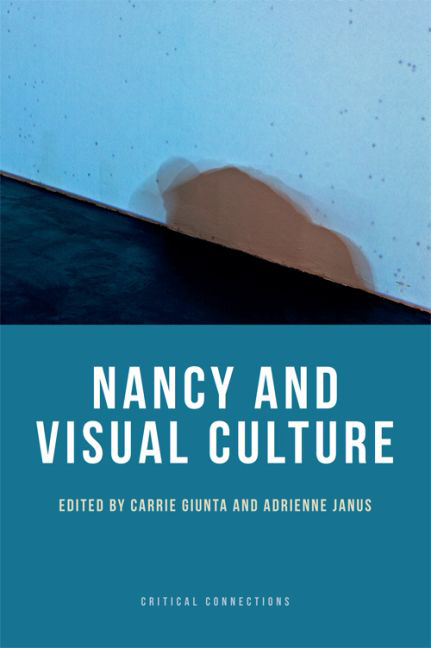Book contents
- Frontmatter
- Contents
- List of illustrations
- Acknowledgements
- Introduction: Jean-Luc Nancy and the Image of Visual Culture
- 1 Cutting and Letting-Be
- 2 Dancing Equality: Image, Imitation and Participation
- 3 A Question of Listening: Nancean Resonance, Return and Relation in Charlie Chaplin
- 4 The Image: Mimesis and Methexis
- 5 On the Threshold: Visual Culture, Invisible Nature
- 6 Pornosophy: Jean-Luc Nancy and the Pornographic Image
- 7 Presentation and Disappearance: Dialogue between Soun-Gui Kim and Jean-Luc Nancy
- 8 Writing in the Place of the Animal
- 9 Together at the Limit: Jean-Luc Nancy, Art and Community
- 10 Turning Around the Written Mark, Opening from a Weight of Thought
- 11 Uncanny Landscapes of Photography: The Partage of Double-Exposure after Jean-Luc Nancy
- Contributors
- Bibliography
- Index
7 - Presentation and Disappearance: Dialogue between Soun-Gui Kim and Jean-Luc Nancy
Published online by Cambridge University Press: 15 September 2017
- Frontmatter
- Contents
- List of illustrations
- Acknowledgements
- Introduction: Jean-Luc Nancy and the Image of Visual Culture
- 1 Cutting and Letting-Be
- 2 Dancing Equality: Image, Imitation and Participation
- 3 A Question of Listening: Nancean Resonance, Return and Relation in Charlie Chaplin
- 4 The Image: Mimesis and Methexis
- 5 On the Threshold: Visual Culture, Invisible Nature
- 6 Pornosophy: Jean-Luc Nancy and the Pornographic Image
- 7 Presentation and Disappearance: Dialogue between Soun-Gui Kim and Jean-Luc Nancy
- 8 Writing in the Place of the Animal
- 9 Together at the Limit: Jean-Luc Nancy, Art and Community
- 10 Turning Around the Written Mark, Opening from a Weight of Thought
- 11 Uncanny Landscapes of Photography: The Partage of Double-Exposure after Jean-Luc Nancy
- Contributors
- Bibliography
- Index
Summary
Originally published by Slought, with the Artsonje Center and the Institut français of South Korea. Edited by Jean-Michel Rabaté and Aaron Levy, Trans. Fiona Moreno and Tchoi Mi-Kyung, in collaboration with Soun-Gui Kim (for the English-Korean translation). This new translation aims not to correct the work done by the translators of the Slought edition, but to render Jean-Luc Nancy's French in a way that coheres with the other translations and chapters in this volume as a whole.
S-G. K: Various aspects seem to characterise the current landscape of art. What we commonly call post-modernism as well as contemporary art already seems distant. This is certainly not unrelated to the movement of globalisation. For several years now, artists, participants in the art world, curators and organisers have been exploring new experiences. The characteristics of this new landscape are numerous. First, the diversity of the arts and the practice of a pluralist aesthetics, the pronounced tendency to explore inter-cultural and cosmopolitan experience; the dissolution and the mixing of expressions, genres, and languages as well as the dehierarchisation of the so-called ‘major’ and ‘minor’ or ‘high’ and ‘low’ arts. This interest in experience and experimentation has as its consequence the disappearance of the object. More precisely, what is significant is the disappearance of the aesthetic object and of the image. All this can be observed here, at the Gwangju Biennale, where the major preoccupation of the event seems to be articulated around the question of presentation itself. In other words, the absence of content seems to constitute the content of art today. I would like to ask you the following question: where does art now find itself? Where is art located? Is what we call art to be found precisely in this very movement of the disappearance of presentation? That's my first question.
J-L. N: Thank you. I'd like to say to you, to the people here today, and to those who will be coming in the next two months to visit the Gwanju Biennale, that I am very pleased to be able to speak with you. I'll try to respond right away to your question. I think that art has never known where it is. In a certain way, this isn't a new question.
- Type
- Chapter
- Information
- Nancy and Visual Culture , pp. 129 - 143Publisher: Edinburgh University PressPrint publication year: 2016



